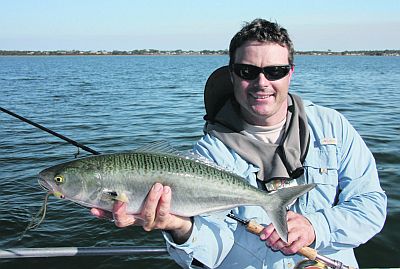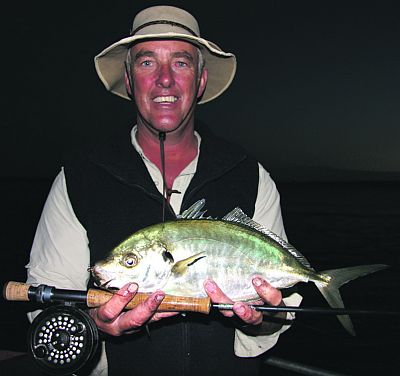 Silver trevally on fly
Silver trevally on fly
Craig Rist
Whenever you set out to target a particular species you need to give yourself half a chance by fishing a place that has a healthy population. Georges Bay at St Helens has a good reputation for producing silvers on soft plastics and bait, so this was an obvious place to spend a couple of days chasing silvers on fly.
I find it really interesting talking to people who have these fish worked out using soft plastics. The wealth of knowledge these guys have experienced over the years is invaluable. I am lucky enough to know a few soft plastic devotees, who are only too happy to share their knowledge of Georges Bay and the silver trevally that inhabit it. Having a few locations up your sleeve is a big help. The size, colour and type of soft plastic used, and the way it is retrieved can also be used to help you develop flies and a method to trigger a response to your fly. That said, there’s nothing quite like time on the water and having a go, to put everything you have learnt into practice.
Georges Bay on fly
With reports of silver trevally and salmon being caught at St Helens, a trip to Georges Bay was inevitable. It didn’t take too much effort convincing Steve and Jim to spend a couple of days fly fishing Georges Bay. We decided to take Steve’s six metre centre console so we could camp on his boat on the bay to maximize our fishing time on the water. With a couple of trips to Cape York, Steve’s boat was already well set up for this type of basic live onboard fishing.
Besides, there’s nothing better than fishing from dawn till dusk then simply anchoring up in a quiet bay and rolling out the swags.
We arrived at St Helens around midday. The usual flock of birds were out in the bay feeding on the bait fish, pushed up to the surface by a school of Australian salmon. After a quick grocery shop we put the boat in at the town boat ramp. We continued past the birds on the bay as they sat motionless on the water waiting for the salmon to provide their next feed.
The tide was still on its way in so we decided to drift over the sandbar opposite the red channel markers to see if we could see any bream. We saw the odd bream, but we couldn’t tempt them to eat our flies. A couple of halfhearted nips to the tail of our Clousers and Salty BMSs and that was it.
As we drifted over the sand bar we also fished the edge of the channel. Our flies were allowed to sink down into the channel before retrieving them back up onto the sandbar. I was fishing a white Muz Wilson’s Hammer Head with the usual Barra strip, two short fast strips followed by a pause then one short fast strip. As the fly came over the sandbar the line suddenly pulled tight as it was taken by strong fish. The loose line on deck quickly disappeared back out through the rod as the fish made a run out into the channel. I applied some pressure through the rod as the drag on the reel took over. I could feel the fish had taken the line through some thick weed on its way out into the channel. This eventually pulled free allowing me to gain the upper hand. To my surprise a small silver trevally came into view. This surprised me a bit as it had fought like a much bigger fish. We decided to see if we could find a few more silvers along the edge of the channel beside the red channel markers.
In this deeper water we used heavier Clousers and Muz Wilson’s Hammer Head flies on clear intermediate lines with eight to ten pound fluorocarbon leaders. We fished the flies back at different depths and retrieves. Jim was the next one to load up his rod into a fish he had hooked down deep on a white Hammer Head. Another strong fight followed with yet another silver trevally.
Every now and then, off in the distance, between us and the Stieglitz boat ramp, a single salmon would leap clear of the water. There were no birds to signal their presence, only the occasional slash or jump that gave them away. The sight of these leaping salmon soon became too much of a temptation so we left the channel markers for a while and drifted down through the area we had last seen them jumping. It didn’t take long for the salmon to lock onto our Surf Candy’s being stripped back to the boat. The next hour was spent hooking up to these salmon without another boat in sight. Australian salmon seem to be tailor made for the saltwater flyfisher. They readily take flies, fight hard and jump, who could ask for anything more?
We eventually returned to the channel markers in search of some more trevally late in the evening, as the tide rushed off the sandbars. We anchored the boat on a likely back eddy and cast our flies up onto the edge of the flats and allowed them to swing down and across into the eddy. I hooked the first trevally on a yellow Hammer Head and Jim and Steve soon followed suit. Steve caught his on an olive shrimp pattern while Jim stuck with the white Hammer Head. When they stopped biting we moved further down the line of channel markers to find a similar location. We found the trevally holding on the edge of the channel where most of the water was being funneled off the sandbars. We caught trevally right up until it was too dark to see, before calling it a day. We anchored up in Moulting Bay for the night, had some fresh squid for tea and then rolled out the swags ready to do it all over again the next day.
Lessons learnt
I think one of the most limiting factors in salt water flyfishing can be the fly line itself. It will spook fish if you cast it over them, and is easily affected by strong currents, pulling your fly away from its intended target. Blind searching an area needs to be done with this in mind. I like to think I’m only fishing the length of my leader when searching an area. Lengthening the cast by only three or four metres at a time. Unfortunately, this all takes time, which is why it’s much easier to cover a lot of water with a lure or soft plastic to find fish.
Clear intermediate fly lines have gone a long way to improve this, but will still spook a school of bream or trevally over shallower water.
The other limiting factor is the sink rate of a fly line and the way it can be swept away with the current before it reaches its designated target. The top and bottom stages of the tide are much easier to fish a fly down deep. Finding back eddies are the next best thing. These back eddies will often hold fish in the slack water on the incoming and outgoing tides.
Trevally like the structure of the channel markers and can be found at different depths and areas around these. We found a good sized trevally holding alongside one of the markers, a metre below the surface. The back of sand bars and rocks are also a hot spot. Interestingly I have also watched a local flyfisher catch trevally amongst schools of feeding Australian salmon.
Flies that worked for us were white or yellow Hammer Heads in sizes 4 to 1, size 1 olive shrimp patterns and size 1,2 and 4, olive and white, Clousers.
We had the best response to the fly when it was retrieved using the Barra strip or a slow strip with a pause. Allowing the fly to swing through the back eddie, after it had come off the sand bar during the outgoing tide, was also effective.
A quiet approach with an electric outboard is always an advantage. On our first trip we didn’t have an electric outboard for Steve’s boat. So we anchored the boat well above the place we intended to fish and lengthened the rope to bring us within casting range. This method allowed us to systematically cover the water until we had fished right up to a channel marker or to the end of a sand bar.
Spending some time researching your target species to better understand them before you go fishing, will always give you the best possible chance of success. Your first trevally on fly, soft plastics or bait is always going to be more rewarding if you have first set out to targeted them in the first place.
Craig Rist









